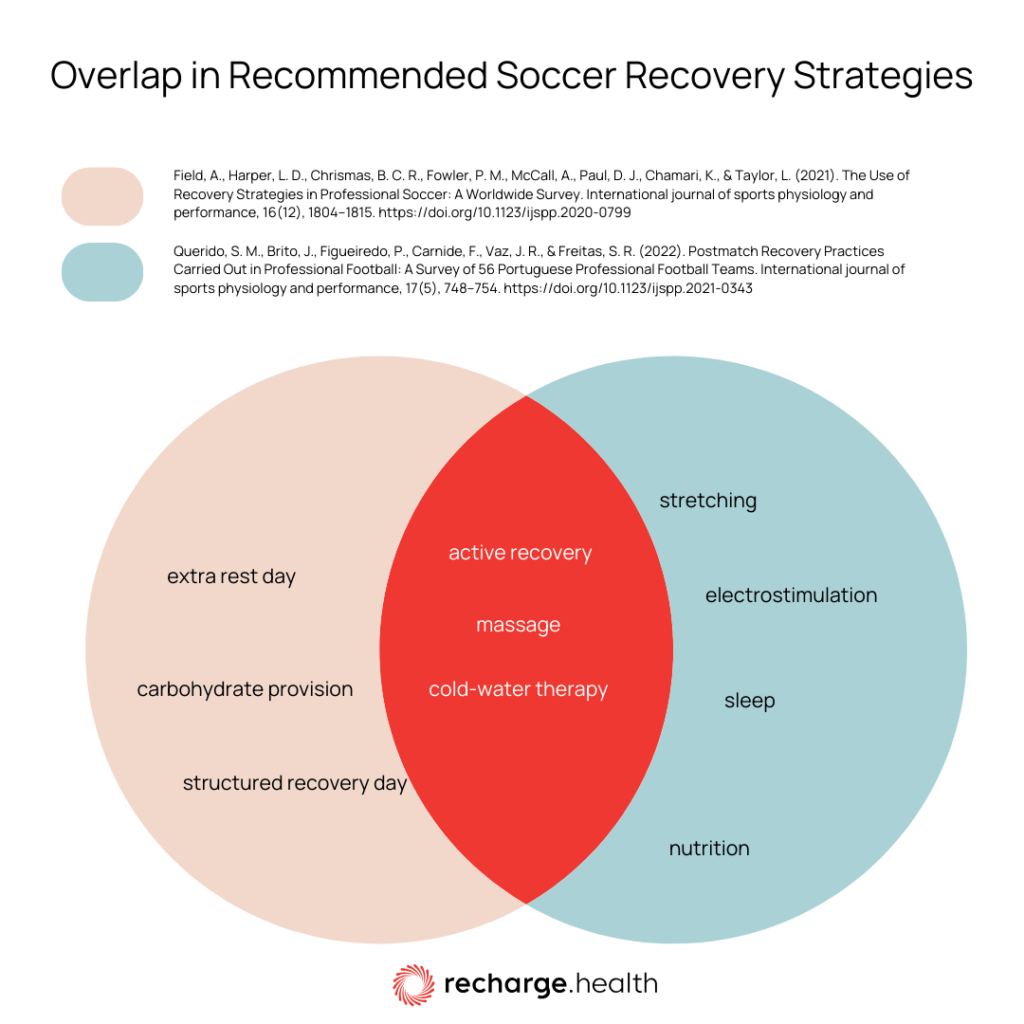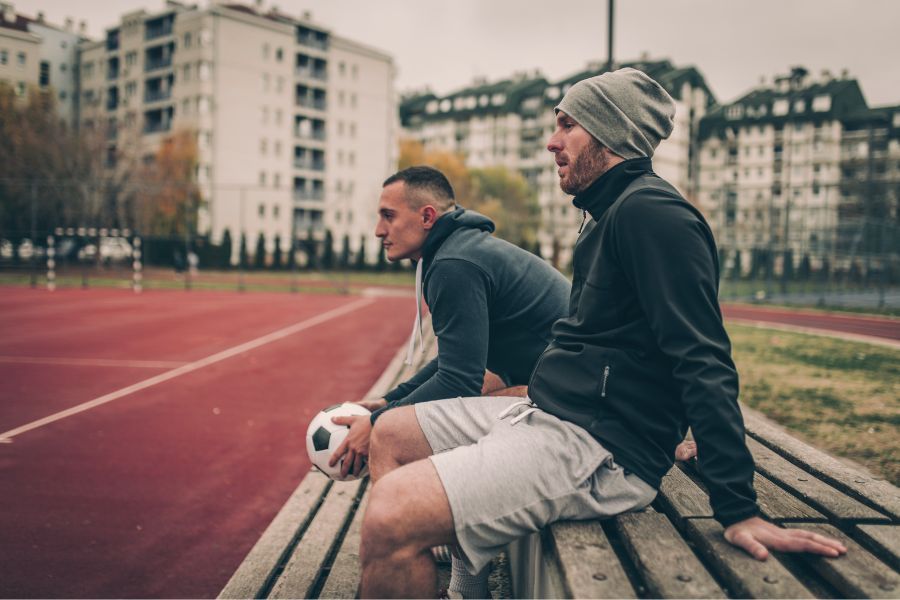Your cart is currently empty!
How to Use Near-Infrared Light for a Football Recovery Session
One of the best ways to avoid football injury is to employ the most effective recovery strategies after a game or intense training.
A worldwide study on the use of recovery strategies in professional football found the primary objectives of recovery to be “alleviating muscle damage/fatigue,” “minimizing injury risk,” and “performance optimization.”
According to the same study, the most typically used recovery strategies were
- active recovery
- structured recovery day
- extra rest day
- massage
- cold-water therapy
- carbohydrate provision predominantly on match day.
Another study focusing on 56 professional Portuguese football teams showed that the most commonly used recovery methods in post-match periods were:
- stretching
- electrostimulation
- active recovery
- cold-water immersion
- nutrition
- sleep
- massage

However, it was impossible to apply these uniformly, and they varied depending on the match location.
In other words, there is an essential need for a recovery strategy that is convenient to apply and handy at any location. And this is where near-infrared light comes in.
In this article, we’re going to discuss how to use near-infrared light for a football recovery session.
Pick the Best Near-Infrared Light Therapy Device
Given the fast-paced life and exercise regimen of football players, the near-infrared device they use for their recovery needs to be convenient, powerful, and targeted. Spending hours in front of panels, in saunas, or adding an additional 30 minutes to any existing regimen is out of the question. That is why it’s important to choose the best red light therapy device out there.
A portable near-infrared device is just the thing. However, ensure that the device of choice still packs enough power, even though it’s not as big as a panel. Factors to take into account are:
- Wavelengths: Choose a device that specifies the light wavelengths it emits. Look for devices within the range of 600-1020nm for optimal healing effects. For red light, the recommendation is 625-635nm, and for near-infrared, 810-850nm is ideal.
- Energy Density: Check the device’s energy density, usually measured in J/cm2. A good device should provide steady energy with an adequate density (e.g., up to 72 J/cm2 with the FlexBeam).
- Effective Irradiance Zone: Red and near-infrared light devices are most effective within the range of 20-200 mW/cm2. Ensure your chosen device falls within this range (e.g., the FlexBeam irradiates 100 mW/cm2).
- Targeted Delivery: Devices that allow for targeted delivery of red light are more effective since moving away from the light source can reduce its effects. You can wrap portable devices like the FlexBeam around the specific area that needs treatment.
- Low nnEMF Emissions: Consider devices that use batteries to reduce exposure to non-native electromagnetic fields (nnEMF) associated with devices plugged into the main electricity supply. nnEMF can have negative health effects.
Create a Sustainable Regimen
Red and near-infrared therapy has been found to effectively lower biochemical markers such as lactate, creatine, and C-reactive protein. These markers are indicators of muscle stress and inflammation often happening due to hard football practice.
By reducing them, red and near-infrared light therapy can help football players combat muscle fatigue, protect muscle fibers from damage, and reduce inflammation resulting from intense training and matches.
Additionally, it can improve oxygen utilization, enhancing your cardiorespiratory fitness and ultimately assisting in achieving peak performance on the football field. Here are some protocols to think about:
Near Infrared Light for Muscle Fatigue
Alleviating muscle damage and/or fatigue was one of the three primary objectives of recovery by professional football players. Sprinting is one of the key elements of football, and repeated sprint exercises in male athletes can lead to the development of severe neuromuscular fatigue of the knee extensors.
Near-infrared light (with wavelengths of 830 nanometers) and red light (660 nanometers) have both been proven effective in delaying the development of skeletal muscle fatigue and improvement of skeletal muscle performance.
Near Infrared Light for Muscle Soreness
Delayed onset muscle soreness is a condition that typically involves muscle pain and stiffness that appears approximately 24 to 72 hours after strenuous or unaccustomed physical exercise, and its symptoms can last anywhere from 3 to 5 days. It’s a condition that is familiar to both elite and novice athletes.
However, the use of near-infrared light after an exercise session can minimize the effects of delayed onset muscle soreness.
Near Infrared Light for Chronic Pain
Playing football intensively, whether professionally or not, can lead to moderate to severe pain, especially though not exclusively in the area of feet, ankles, hip, and groin.
Near-infrared light therapy is safe and effective in the treatment of various chronic pains, including musculoskeletal low back pain, as well as in stimulating healing and reducing inflammation. Thanks to these anti-inflammatory properties, this type of treatment can significantly contribute to improving and accelerating football recovery.

Chronic back injury is a common football overuse injury.
Near Infrared Light for Better Sleep
Sufficient hours of high-quality sleep is not only one of the most effective football recovery strategies (as mentioned by the professional football players in the introduction), but it’s also an essential part of a well-functioning immune system. Unfortunately, professional athletes often suffer from lack of proper sleep caused by high levels of stress, frequent travel, etc.
A study on the sleep quality and endurance performance of professional Chinese female basketball players found that therapy treatments using near-infrared light can trigger the release of melatonin, a hormone in charge of regulating sleep patterns. In this way, near-infrared light can successfully improve sleep quality and, consequently, football recovery.
Near Infrared Light for Traumatic Brain Injury
Acute traumatic brain injury is a major concern in football . According to a study of 53 active players from several professional Dutch football clubs, football’s concussion rates per 1,000 players equal those of American football players. The players in this study exhibited impaired performances in memory, planning, and visuoperceptual processing due to the number of concussions incurred in football and the frequency of “heading” the ball.
Higher wattage near-infrared light lasers (10–15 W at 810 nanometers) have shown excellent clinical results with zero side effects in reaching the depths of the brain without tissue heating or damage. Near-infrared light has also been successful in improving cognitive function and decreasing the symptoms of traumatic brain injury.
What Is Near-Infrared Light Therapy and How to Do It?
Therapy treatment using near-infrared light may sound like a recent innovation, but it’s been around for more than a century. NASA scientists researched and developed it in the 1990s. It’s also known by various terms, including photobiomodulation, near-infrared and red light therapy, and LED light therapy.
All these terms refer to a type of therapy using light-emitting diodes (LEDs) that emit near-infrared and red light. This light imitates natural sunlight at sunset and dawn, all without the hazardous UV rays that can cause serious damage to the skin.
Even though near-infrared and red light work in tandem as a part of this mode of therapy, they actually serve quite different functions. Red light is visible, and its wavelengths are shorter (typically 630 to 700 nanometers). This makes them primarily effective closer to the skin’s surface.
Near-infrared light is invisible and much longer (from 700 to 2,500 nanometers), which makes it effective for use both on the surface of the skin as well as an inch and a half beyond it, affecting a whole range of bodily processes.
The great advantage of near-infrared light therapy is that it can be applied anywhere, anytime by the user themselves. That’s one of the strengths of a portable device like the Flexbeam. This is a crucial factor for any of the football recovery strategies. Near-infrared light is a safe and effective type of therapy treatment. Additionally, it’s natural, chemical-free, non-invasive, and highly affordable.
Because of convenience and ease of use, near-infrared light therapy is on its way to becoming one of the most effective and popular football recovery strategies.
